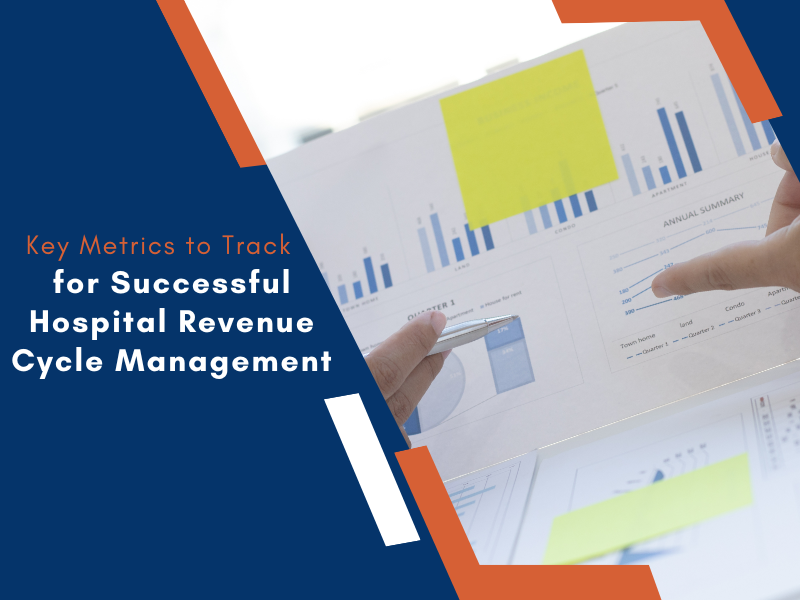Managing the revenue cycle effectively is crucial for any hospital’s financial health. Hospital revenue cycle management encompasses the entire process of managing patient service revenue, from appointment scheduling to final payment collection. Tracking the right metrics can help healthcare providers improve cash flow, reduce denials, and maintain compliance. This blog will discuss the essential metrics every hospital should monitor to achieve efficient and successful revenue cycle management.
1. Clean Claim Rate
The clean claim rate measures the percentage of claims submitted without errors. A high clean claim rate ensures faster reimbursement from insurance companies and reduces administrative burdens caused by rework.
- Why It Matters: Errors in claims can lead to denials or delayed payments. Tracking this metric helps hospitals identify issues in their billing process and implement corrective measures.
- Best Practice: Aim for a clean claim rate of at least 95%. Regular staff training and automated claim scrubbing tools can significantly improve this rate.
2. Days in Accounts Receivable (A/R)
This metric indicates how long it takes to collect payments from patients and insurers. Days in A/R is a direct reflection of your hospital’s cash flow efficiency.
- Why It Matters: A high number of days in A/R means cash is tied up in unpaid claims, which can strain hospital operations.
- Best Practice: Keep this number below 40 days. Implementing electronic payment systems and following up promptly on outstanding claims can shorten the A/R period.
3. Denial Rate
The denial rate shows the percentage of claims rejected by payers. A high denial rate signals inefficiencies in coding, documentation, or patient eligibility verification.
- Why It Matters: Denials cost time and money to rework and can delay the payment cycle. Tracking this metric helps identify the root causes of denials.
- Best Practice: Maintain a denial rate below 5%. Analyze denial trends regularly to pinpoint problem areas, such as insufficient documentation or incorrect codes.
4. Net Collection Rate
This metric reflects the percentage of revenue collected from the amount billed, after adjusting for contractual allowances and write-offs.
- Why It Matters: The net collection rate provides a clear picture of how much revenue your hospital is effectively collecting compared to its potential revenue.
- Best Practice: Aim for a net collection rate of 95% or higher. Focus on improving patient collections and ensuring accurate billing practices.
5. Cost to Collect
This metric measures the expenses incurred to collect payments, including staff salaries, technology, and administrative costs.
- Why It Matters: A high cost-to-collect ratio reduces profitability. Monitoring this metric ensures your hospital’s revenue cycle operations remain cost-effective.
- Best Practice: Keep your cost-to-collect ratio below 3%. Use automation to reduce manual tasks and streamline processes like patient billing and follow-ups.
6. Patient Payment Collection Rate
With the rise of high-deductible health plans, patient payments now make up a significant portion of hospital revenue. The patient payment collection rate tracks how effectively your hospital collects these payments.
- Why It Matters: Patients are often slow to pay their medical bills, leading to cash flow issues. Tracking this metric helps hospitals refine their billing strategies.
- Best Practice: Simplify the payment process with online portals, provide clear billing information, and offer payment plans to encourage timely payments.
7. First Pass Resolution Rate (FPRR)
The FPRR measures the percentage of claims resolved successfully on the first submission. A higher FPRR reduces administrative burdens and improves cash flow.
- Why It Matters: Low FPRR indicates inefficiencies in claim submissions, such as coding errors or missing information.
- Best Practice: Aim for an FPRR above 90%. Regularly audit your claims for accuracy before submission and leverage advanced coding tools to minimize errors.
8. Bad Debt Percentage
Bad debt refers to unpaid bills that are unlikely to be recovered. This metric measures the percentage of revenue written off as bad debt.
- Why It Matters: High levels of bad debt indicate ineffective patient billing and collection strategies.
- Best Practice: Reduce bad debt by verifying insurance eligibility upfront, offering financial counseling, and setting up payment plans for patients.
9. Payer Mix Analysis
Payer mix analysis breaks down revenue by payer types, such as Medicare, Medicaid, private insurers, and self-pay patients.
- Why It Matters: Different payers have different reimbursement rates, impacting hospital revenue. Understanding your payer mix helps optimize contract negotiations and revenue strategies.
- Best Practice: Regularly analyze and adjust your payer mix to ensure a balanced and sustainable revenue stream.
10. Claim Lag Time
Claim lag time tracks the duration between patient service and claim submission.
- Why It Matters: Longer lag times delay reimbursement and create cash flow issues.
- Best Practice: Keep claim lag time below five days. Streamline documentation and coding processes to speed up claim submissions.
Strategies for Monitoring These Metrics
Tracking these key metrics requires robust tools and systems. Here are some strategies for effective monitoring:
- Leverage Technology: Use revenue cycle management software to automate billing, coding, and reporting processes.
- Regular Audits: Conduct regular audits of claims, denials, and accounts receivable to identify inefficiencies.
- Employee Training: Train staff on the latest billing codes, regulations, and payer requirements to reduce errors.
- Patient Engagement: Improve communication with patients regarding billing and payment options to enhance collections.
- Data-Driven Decisions: Use insights from metrics to make informed decisions about staffing, technology investments, and process improvements.
The Importance of Partnering with Experts
Managing the revenue cycle in-house can be complex and resource-intensive. Partnering with a trusted service provider can significantly improve efficiency and financial performance. An experienced partner can help monitor these key metrics and provide actionable insights to optimize your hospital revenue cycle management processes.
Why Choose Apaana Healthcare?
At Apaana Healthcare, we understand the challenges hospitals face in managing their revenue cycles effectively. That’s why we offer comprehensive solutions tailored to your needs.
Apaana Healthcare drives operational excellence with global healthcare management solutions. We specialize in outsourced services for health plans, covering:
- Member Enrollment: Ensuring seamless registration and coverage for patients.
- Claims Administration: Managing claims efficiently to reduce denials and accelerate payments.
- Medical Billing & Coding: Providing accurate coding and billing services to maximize revenue.
- Provider Engagement: Strengthening relationships with providers to enhance collaboration.
Our expertise ensures cost-effective solutions that improve cash flow, reduce operational burdens, and allow healthcare providers to focus on what matters most—patient care.
Take the first step toward optimized hospital revenue cycle management today. Partner with Apaana Healthcare for reliable, efficient, and innovative solutions.





